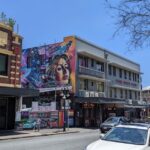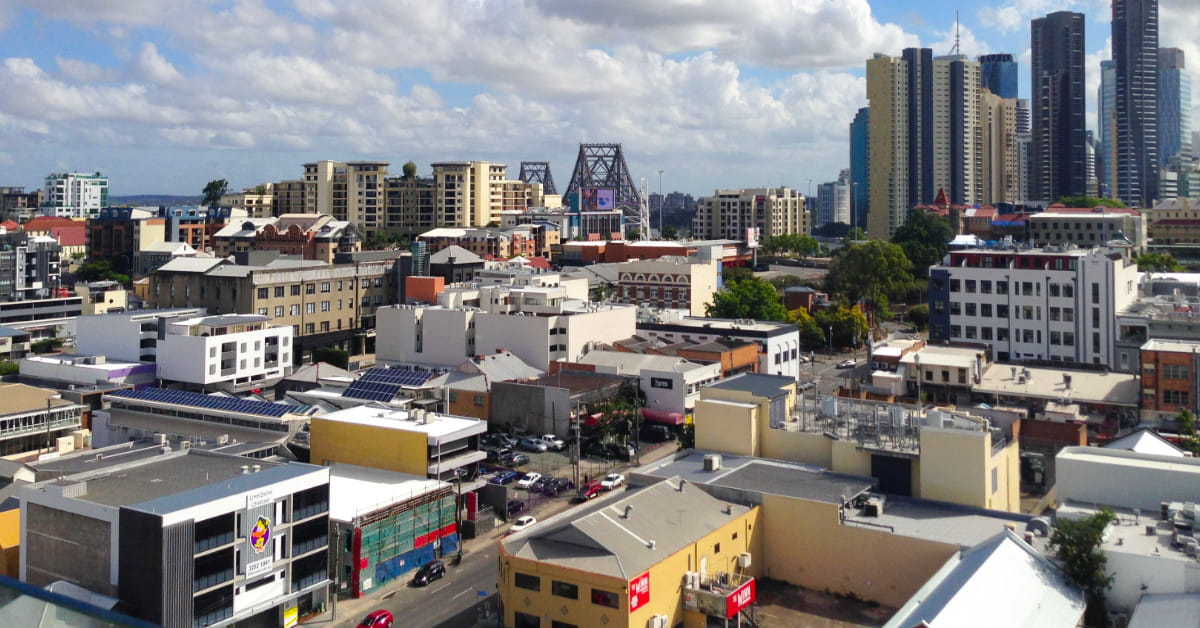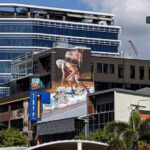Fortitude Valley’s rich history comes alive through its iconic heritage sites, each telling a unique story of the area’s vibrant past. From grandeur-filled department stores to architectural masterpieces, these landmarks reflect the Valley’s transformation over decades. Whether it’s the Art Deco charm of McWhirter’s, the poignant history of the Whiskey Au Go Go site, or the enduring elegance of Doggett’s Cottage, these sites are more than just buildings—they’re a reflection of Brisbane’s heritage. This guide invites you to uncover the fascinating stories behind the Valley’s most treasured landmarks.
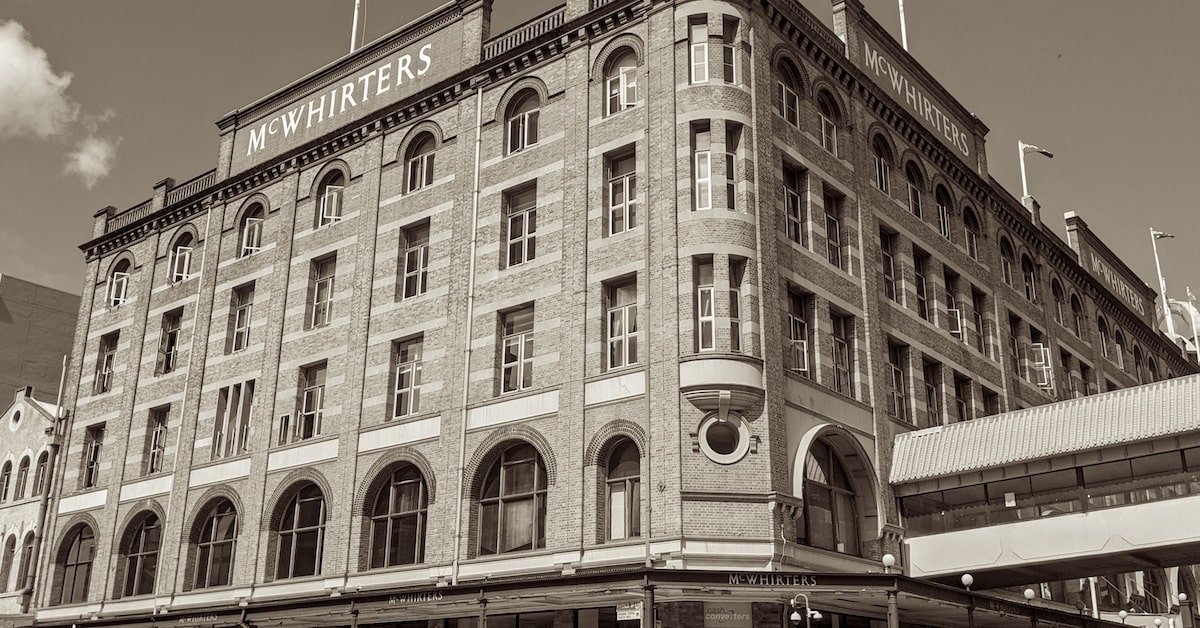
Commerce and Retail
McWhirter’s Department Store
McWhirter’s Department Store, a prominent landmark at 247 Wickham Street, stands as a testament to the Valley’s rich retail history. The building’s striking Art Deco style immediately captures attention, reflecting the architectural trends of the era in which it was established – 1898.
- McWhirter’s was a renowned department store that catered to the diverse needs of Brisbane residents. It offered a wide array of goods, from fashion and homewares to toys and appliances, becoming a beloved shopping destination for generations.
- The store’s success mirrored the growth of Fortitude Valley, transforming it into a bustling commercial hub. McWhirter’s played a pivotal role in shaping the Valley’s identity as a retail and entertainment destination.
- Over time, McWhirter’s underwent various transformations, reflecting changing retail trends and consumer preferences. However, its core values of quality and customer service remained constant, solidifying its place in Brisbane’s retail landscape.
Today, the McWhirter’s building houses both McWhirters Retail and heritage apartments. This blend of retail and residential spaces reflects the evolving nature of urban landscapes, where historical structures adapt to contemporary needs while preserving their architectural legacy. The building’s enduring presence on Wickham Street serves as a reminder of McWhirter’s significant contribution to the Valley’s commercial and social fabric.
📍 247 Wickham Street
TC Beirne Department Store
T.C. Beirne Department Store, a retail icon in Brisbane’s history, was established in 1902 and graced Brunswick Street in Fortitude Valley. The store’s founder, Irishman T.C. Beirne, is recognized as Australia’s first self-made millionaire. This achievement reflects the store’s remarkable success and Beirne’s entrepreneurial spirit.
- By 1910, the Overell Department Store, which also had a presence on Brunswick Street, boasted an impressive 20 departments. This expansion indicates the flourishing retail sector in Fortitude Valley during this period.
- The Valley was home to multiple department stores, including McWhirter’s, Myer, and David Jones. This concentration of major retailers underscores the Valley’s prominence as a shopping destination.
Today, the legacy of T.C. Beirne’s department store lives on as part of Chinatown Mall on Duncan Street. The building, though repurposed, stands as a reminder of the Valley’s rich commercial past and the impact of visionary entrepreneurs like T.C. Beirne.
📍 28 Duncan Street
Overell’s Department Store
Overell’s Department Store, a prominent retailer in Fortitude Valley, had a significant presence on Brunswick Street. The store’s success is evident in its expansion, reaching 20 departments by 1910. This growth reflects the booming retail sector in Fortitude Valley during this era, with multiple department stores, including McWhirter’s, Myer, and David Jones, all vying for customers.
To cater to the increasing demand, Overell’s expanded its operations by establishing a second store on Wickham Street in 1910. This strategic move highlights the store’s commitment to serving the diverse needs of the Valley’s growing population.
- The Wickham Street store specialized in menswear, offering a curated selection of apparel and accessories tailored to the discerning male shopper.
- The original store on Brunswick Street continued to focus on womenswear and accessories, providing a wide range of fashion and lifestyle products for women.
Overell’s Department Store’s dual presence on Brunswick and Wickham streets solidifies its position as a major player in Fortitude Valley’s retail landscape.
📍 250 Wickham Street
Swift’s Building
Swift’s Building, a prominent landmark at 201 Wickham Street, holds a commanding position at the intersection once known as the “Valley Corner.” Constructed in 1905, the building stands as a testament to the rapid growth and development of Fortitude Valley during the early 20th century.
- The intersection of Wickham and Brunswick Streets was a bustling hub of activity, marking the heart of the Valley’s commercial and social life. Swift’s Building, with its prominent location, would have witnessed the ebb and flow of city life, from shoppers and workers to trams and carriages.
- The building’s construction in 1905 coincided with a period of significant transformation in Fortitude Valley, with numerous businesses and entertainment venues emerging, catering to the growing population and the city’s expanding economy.
- The presence of other major department stores like McWhirter’s, Overell’s, Myer, and David Jones further solidified the Valley’s reputation as a premier shopping destination. Swift’s Building, with its strategic location, would have been an integral part of this vibrant retail landscape.
Today, Swift’s Building stands as a reminder of the Valley’s rich commercial past and the enduring legacy of businesses that shaped the suburb’s identity.
📍 201 Wickham Street
Shannon’s Building and Winn Street Warehouse
Shannon’s Building and the Winn Street Warehouse, located at 717 and 697 Ann Street, respectively, are two-story brick structures that reflect the thriving commercial activity in Fortitude Valley during the 1920s. They were constructed in 1924, a period of significant growth and development for the area.
- Shannon’s Building housed a variety of shops, catering to the diverse needs of the Valley’s residents and visitors. The building’s brick construction reflects the prevailing architectural style of the time, emphasizing durability and functionality.
- The Winn Street Warehouse, situated behind Shannon’s Building, provided storage space for businesses operating in the area. The warehouse’s strategic location, close to the shops and businesses on Ann Street, facilitated the efficient movement of goods and merchandise.
The construction of these buildings coincides with the establishment of Centenary Place in 1925, and the subsequent reconfiguration of roads and the emergence of a new commercial precinct on Wickham Street. This period of urban transformation highlights the dynamic nature of Fortitude Valley, where new developments and initiatives continually reshape the suburb’s landscape and identity.
📍 717 and 697 Ann Street
Bragg’s Bakery and Apothecaries Hall
Bragg’s Bakery and Apothecaries Hall are two historic buildings located in Fortitude Valley. They stand side-by-side on Ann Street, and Bakery Lane, a heritage-listed laneway, runs behind them. Both were built in the 1880s, reflecting the commercial growth of the area at that time.
Bragg’s Bakery opened at 694 Ann Street in 1865, operating for over forty years. When Joseph Bragg died in 1883, his wife Kate took over the bakery and became a master baker. This was a rare accomplishment for a woman during that time period. By 1888, Kate Bragg and her employees were baking up to 700 loaves per day!
Apothecaries Hall, located at 690 Ann Street, still looks much the same as when it was built in 1882. The building originally housed a business that sold imported medications and surgical instruments, and even offered dental services using “instruments of the ‘most modern invention'”. For many years, Brisbane residents knew this building as the home of Downes Shoes, and more recently, it has housed a variety of restaurants facing Wickham Street.
📍 694 Ann Street
The Queensland Brewery Company Building
The Queensland Brewery Company Building, located at 501 Ann Street in Fortitude Valley, is a heritage-listed office building and warehouse. The building, which replaced the company’s headquarters in Queen Street, Petrie Bight, was designed by Herbert Stanley Macdonald of Addison and Macdonald and constructed between 1940 and 1942.
- The design of the Queensland Brewery Company Building was unique for its time, blending Art Deco and Functionalist styles.
- The ground and first floors were used as offices, while the remaining space was dedicated to cellars, a wine and spirits department, a cooperage, and goods handling and loading.
In 1966, the building was purchased by the Royal Automobile Club of Australia (RACQ) and adapted for its new use. In 1980, the property was sold to the Australia Post and Telecom Credit Union, and then to Credit Union Australia in 1983.
The Queensland Brewery Company Building is significant for its architectural style, its association with the Queensland Brewery Company and subsequent occupants, and its role in demonstrating the evolution of commercial architecture in Queensland.
📍 501 Ann Street
The Prince Consort Hotel
The Prince Consort Hotel, a grand three-storey structure located on Wickham Street in Fortitude Valley, opened its doors in 1888. Designed by prominent colonial architect Richard Gailey, the hotel was built during a period of significant growth and prosperity in Brisbane. Initially, it boasted an impressive array of features, including one of the largest bars in the city, three parlours, a spacious dining room, a billiard room, a kitchen, a cellar, six bathrooms, and 28 bedrooms. Adding to its commercial appeal, four large shops occupied the ground floor. A reception area, known as the Club Room, ran the length of the first floor, adding to the hotel’s grandeur and social appeal.
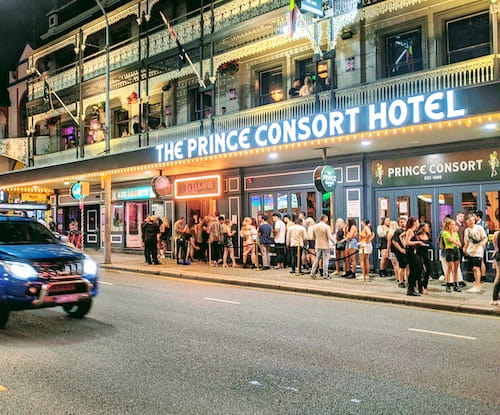
Over the years, the Prince Consort has evolved while retaining its historic charm. The entry foyer still showcases its art deco features, including tiled walls, ornate plaster ceilings, wooden doors with etched glass panels, and a 1930s lift. Today, The Prince Consort is a vibrant entertainment hub, renowned for hosting iconic parties and attracting renowned artists. It has become a testament to Brisbane’s evolving social scene, blending its rich history with contemporary entertainment trends.
📍 230 Wickham Street
The Wickham Hotel
The Wickham Hotel, a three-story masonry structure erected in 1885, stands as a testament to the Valley’s rich and diverse history. Located at 728 Ann Street, it has been a constant presence amidst the evolving landscape of Fortitude Valley.
- Since the 1970s, the Wickham Hotel has been a beacon of inclusivity, proudly embracing the LGBTQIA+ community. This commitment to diversity has made it a beloved landmark and a safe haven for many. It is the home of Big Gay Day, Brisbane’s largest LGBTQIA+ festival. This association underscores the Wickham Hotel’s significance as a cultural hub and a place of celebration.
- The Wickham Hotel’s long history, dating back to 1885, places its construction within the same era as other prominent Valley landmarks like the Empire Hotel (1888) and the Prince Consort Hotel (1888). These establishments, each with their unique character and contributions, collectively shaped the Valley’s identity as a center of entertainment and social life.
- The Wickham Hotel’s enduring presence speaks to its ability to adapt and thrive amidst changing social and cultural landscapes. Its embrace of the LGBTQIA+ community reflects a commitment to inclusivity and a celebration of diversity that resonates with contemporary values.
Today, the Wickham Hotel stands as a symbol of progress and acceptance, honoring its heritage while creating a modern and welcoming space for all.
📍 728 Ann Street
The Empire Hotel
The Empire Hotel, a grand establishment located at 339 Brunswick Street, has been a prominent fixture in Fortitude Valley since 1888. The hotel’s ornate design, reflecting the architectural trends of the era, was the work of renowned colonial architect Richard Gailey, who also designed the Valley Presbyterian Church and School on Warner Street.
- Originally, The Empire Hotel was twice its current size, spanning across both Ann and Brunswick streets. This expansive footprint highlights the hotel’s significance in the Valley’s early development, serving as a social and commercial hub.
- Over time, like many historical structures, The Empire Hotel has undergone transformations, adapting to the evolving needs of the community. However, it has retained much of its original charm, particularly in its entry foyer.
The foyer’s art deco features remain a testament to the hotel’s rich past, showcasing tiled walls, ornate plaster ceilings, wooden doors adorned with etched glass panels, patterned floors, and a vintage 1930s lift. These architectural details provide a glimpse into the hotel’s grandeur during its heyday. While the apartment wing that once stretched along Ann Street has since been demolished, the upper floor, originally designed for accommodation, still retains its layout of bedrooms and bathrooms arranged around a central corridor.
Today, The Empire Hotel continues to be a vibrant part of the Valley’s nightlife scene. Its enduring presence on Brunswick Street speaks to its resilience and ability to adapt while retaining its historical significance.
📍 339 Brunswick Street
The Royal George Hotel and Ruddle’s Building
The Royal George Hotel, a three-story rendered masonry building located at the corner of Ann and Brunswick Streets in Fortitude Valley, has a rich history dating back to 1850. The hotel has undergone numerous alterations, evolving from a modest two-story inn to a grand Victorian establishment, and finally taking on its current 1960s form. William Ruddle, who became associated with the hotel in 1872, played a key role in its development. During his ownership, the hotel underwent significant additions, including a third floor, solidifying its Victorian character.
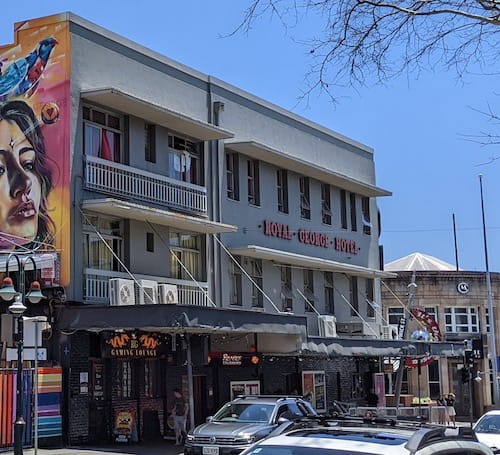
Adjacent to the Royal George stands Ruddle’s Building, a two-story brick structure built in 1901. Designed by renowned architect Robin Dods, the building was commissioned by William Ruddle to complement the hotel’s Victorian style. Ruddle’s Building housed various commercial tenants, including the Commercial Banking Company of Sydney, which occupied a specifically designed space within the building. Both the Royal George Hotel and Ruddle’s Building are important landmarks in Fortitude Valley, reflecting the area’s growth and architectural trends over time. They are also notable for their association with prominent figures in Brisbane’s history, including William Ruddle and architect Robin Dods.
📍 323–335 Brunswick Street
Entertainment Landmarks
Site of the ‘Whiskey Au Go Go’ Bombing
The site of the ‘Whiskey Au Go Go’ bombing, located at 356 St Pauls Terrace, stands as a somber reminder of one of Australia’s most horrific acts of violence. On the night of March 8, 1973, this once-popular nightclub was the target of a devastating firebombing attack that claimed the lives of 15 innocent people. This tragedy remains one of the worst mass murders in Australian history, leaving an enduring scar on the community and the nation.
- The ‘Whiskey Au Go Go’ bombing stands as a stark reminder of the vulnerability of public spaces and the devastating consequences of hate and violence.
- The event prompted a national outcry and a reassessment of safety and security measures in public venues.
The site serves as a memorial to those who lost their lives and a call for continued vigilance against violence in all its forms.
📍 356 St Pauls Terrace
Religious and Community Services
Valley Presbyterian Church and School
The Valley Presbyterian Church and School, located at 25 Warner Street, are significant landmarks in Fortitude Valley, reflecting the area’s religious and educational heritage. The church, designed by renowned colonial architect Richard Gailey, was constructed in 1885, a period of substantial growth and development in Fortitude Valley.
The adjacent Sunday School building, erected in 1906, provided religious education to the congregation’s children, further solidifying the church’s role as a center of community life.
- The Valley Presbyterian Church and School stand in contrast to the Catholic institutions of Fortitude Valley, such as St. Patrick’s Church and the site of the Holy Name Cathedral. Their presence highlights the diversity of religious denominations that shaped the Valley’s cultural landscape.
- The church’s design by Richard Gailey, a prominent architect who also designed the Empire Hotel on Brunswick Street, emphasizes the Valley’s architectural significance and the enduring legacy of skilled craftsmanship in the area.
- The establishment of the Sunday School in 1906 underscores the church’s commitment to education and its integral role in nurturing the younger generation.
📍 25 Warner Street
St. Patrick’s Church
St. Patrick’s Church, a heritage-listed Roman Catholic church at 58 Morgan Street, is a grand example of late 19th-century Gothic architecture in Brisbane. Constructed between 1880 and 1882, it replaced an earlier church on Wickham Street to accommodate the growing Catholic population in Fortitude Valley.
Designed by renowned architect Andrea Giovanni Stombuco, the church is notable for its impressive size and intricate details. Built with local porphyry and Murphy’s Creek sandstone, it features:
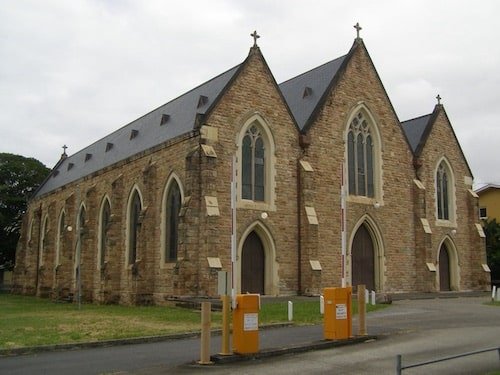
- A spacious nave with octagonal columns and pointed arches.
- Intricately crafted timber trusses with decorative motifs.
- A stunning stained-glass window imported from Lyon, France.
- A high altar sculpted from New Zealand Oamaru stone.
- An organ built by celebrated local craftsman Thomas Christmas.
St. Patrick’s Church has served as a cornerstone of the Catholic community in Fortitude Valley for over a century. While the parish was dissolved in 1990, the church continues to draw large crowds for Sunday Mass and remains a popular venue for weddings and baptisms.
📍 58 Morgan Street
Holy Trinity Anglican Complex
Holy Trinity Church is a substantial brick and stone building located on a site bound by Church, Wickham, and Brookes Streets in Fortitude Valley. The church precinct includes the Holy Trinity Parish Hall and the Holy Trinity Rectory, both of which are also heritage-listed. The first rector of Holy Trinity Parish was appointed in 1856. Parishioners initially gathered for services in a rented cottage at the corner of Ann and Ballow Streets. Construction on the current church building began in 1876 and finished in 1877. The chancel and sanctuary were added in 1921, and the clerestory windows were remodeled in 1925. The reredos, the last major addition to the church, was dedicated in 1929.
📍 141 Brookes Street, Fortitude Valley
All Hallows’ Convent and School
All Hallows’ Convent and School is a heritage-listed girls’ school located at 547 Ann Street in Fortitude Valley. The Sisters of Mercy founded the school on this site in 1863 under the direction of Queensland’s first Catholic bishop, James Quinn. The school has played a significant role in the education of girls in Brisbane for over 150 years.
All Hallows’ has a long and rich history, and its buildings and grounds reflect this. The school has expanded over the years and now includes a mix of old and new buildings, all set within beautifully landscaped grounds. The school continues to be a vibrant and important part of the Fortitude Valley community.
📍 547 Ann Street, Fortitude Valley
Holy Name Cathedral Site
The Holy Name Cathedral site, located at 586 Ann Street, stands as a poignant reminder of a grand vision that was ultimately thwarted by economic hardship. Originally intended to be the largest Catholic cathedral in the Southern Hemisphere, the project commenced in 1928 but was tragically halted by the onset of the Great Depression.
- The ornate wall that remains today serves as a haunting reminder of the ambitious scale of the intended structure. It offers a glimpse into what could have been a magnificent landmark in Fortitude Valley and a testament to the aspirations of the Catholic community at the time.
- The project’s demise due to the economic downturn reflects the broader societal impacts of the Great Depression, which brought widespread hardship and forced the abandonment of countless projects.
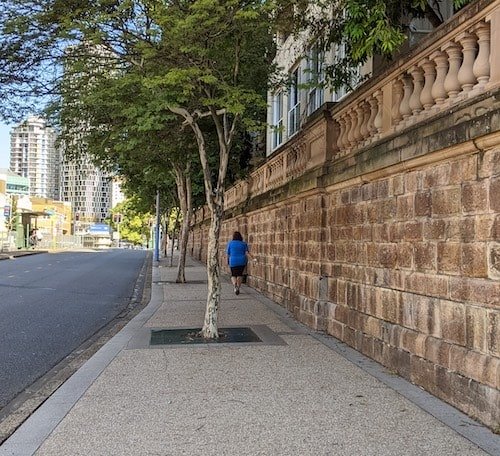
The Holy Name Cathedral site stands in stark contrast to St. Patrick’s Church on Morgan Street, which, though built during a period of financial strain for the Brisbane diocese, was successfully completed in 1882. The two sites offer a compelling narrative of ambition, resilience, and the enduring impact of economic forces on architectural aspirations.
📍 586 Ann Street
Civic and Public Services
Fortitude Valley Post Office
The Fortitude Valley Post Office, situated at 740 Ann Street, stands as a testament to the Valley’s vibrant past. Constructed in 1887, it embodied the area’s rapid growth and prosperity during that era. The building’s design, with its distinct separation of functions, mirrored the importance of communication and commerce in the evolving suburb.
- The ground floor served as the heart of communication, housing the essential postal and telegraph services. These services were crucial for both burgeoning businesses and individuals, facilitating the exchange of information and fostering connections within the community and beyond.
- In contrast to the bustling activity below, the upper floor provided a more private domain, serving as the residence for the postmaster and his family. This co-location of work and living spaces underscored the post office’s integral role in the community, positioning it as a vital hub where public service and private life intertwined.
The passage of time has brought about a remarkable transformation for the former Fortitude Valley Post Office. Today, it has been reborn as ‘The GPO’ nightclub. This evolution involved a substantial $9 million makeover, culminating in its grand reopening in June 2023. The building’s metamorphosis exemplifies the adaptability of heritage structures, showcasing their potential to embrace new purposes while retaining echoes of their historical significance. The GPO’s current incarnation as a bustling entertainment venue stands in stark contrast to its former role as a hub of communication, yet it continues to serve as a gathering place, albeit for a different purpose.
📍 740 Ann Street
Fortitude Valley Air Raid Shelters
The Fortitude Valley Air Raid Shelters, a group of four reinforced concrete structures, stand as silent witnesses to a period of heightened anxiety and preparation in Brisbane’s history. Constructed in 1942 by the Brisbane City Council, these shelters were part of a larger network of air raid precautions implemented throughout the city in response to the threat of Japanese air raids during World War II. Three of these shelters are located along East Street, while the fourth stands on Wickham Street, near their intersection.
- These shelters were strategically placed around a children’s playground that had been established in 1922. The playground, managed by the Queensland Playground Association, was a hub for children from working-class families in the inner suburbs of Brisbane, making it crucial to provide protection in case of an air raid.
- The design of the shelters reflects a forward-thinking approach by their creator, Frank Gibson Costello, who served as the Brisbane City Council’s City Architect from 1941 to 1952. Costello envisioned these shelters having a dual purpose, serving as park shelters or bus stops once the war ended and their protective walls were removed.
- This dual-purpose design highlights the resourcefulness and pragmatism of wartime planning in Brisbane. Faced with limited resources and an uncertain future, city officials sought to create infrastructure that could serve the community both during and after the conflict.
- Ironically, the Fortitude Valley Air Raid Shelters, like many others across Brisbane, were never put to their intended use during the war. Brisbane was spared from Japanese air raids, though other parts of Queensland, such as Horn Island, Townsville, and Miallo, were targeted.
Today, the Fortitude Valley Air Raid Shelters remain as a poignant reminder of a bygone era, a testament to the resilience and adaptability of a community facing the uncertainties of war. The removal of their blast walls, as Costello envisioned, has allowed them to seamlessly integrate into the urban landscape, serving as shelters for parked motorcycles and scooters in a narrow park adorned with gardens and paving. Their continued presence serves as a tangible link to Brisbane’s wartime history and the enduring legacy of those who prepared for a threat that, thankfully, never materialized.
Centenary Place
Centenary Place, a heritage-listed park located at 85 Wickham Street, Fortitude Valley, was established in 1925 to commemorate the centenary of European settlement in Queensland. The park features statues, palm trees, lush gardens, and mature fig trees, creating a serene oasis amidst the bustling urban landscape. It is a starting point for a walking tour that focuses on the Valley’s social and retail history. The tour concludes at the historic Holy Trinity Anglican Church.
The creation of Centenary Place involved the reconfiguration of roads in the surrounding area, leading to the construction of a row of shops in the 1920s. This development reflects the ongoing evolution of Fortitude Valley, where historical events and urban planning initiatives have shaped the suburb’s character.
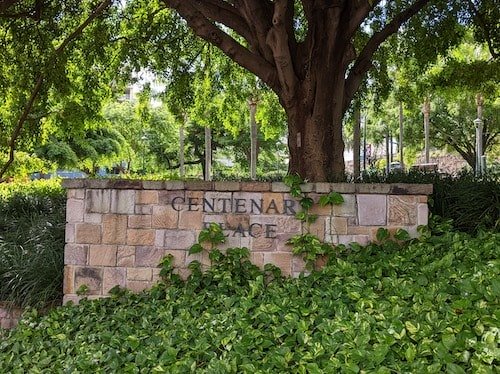
Centenary Place serves as a reminder of Queensland’s history and the transformation of Fortitude Valley from a colonial settlement to a vibrant commercial and entertainment hub.
📍 85 Wickham Street
Valley Fiveways Building
The Valley Fiveways Building, a 1928 brick structure located at 187 Brunswick Street, played a significant, albeit infamous, role in a pivotal moment in Queensland’s history—the Fitzgerald Inquiry. This inquiry, a major turning point in the state’s political and social landscape, exposed widespread corruption within the Queensland Police Force and government, ultimately leading to significant reforms. The Valley Fiveways Building’s connection to this event highlights the intertwined nature of Fortitude Valley’s history with the broader narrative of Queensland’s development.
- The building’s construction in 1928 coincided with a period of economic prosperity and rapid growth for Fortitude Valley, as evidenced by the emergence of numerous commercial and entertainment venues, including department stores, theaters, and hotels.
- The Fitzgerald Inquiry, which took place decades later, exposed a darker side of Queensland’s past, revealing a culture of corruption and misconduct that had permeated the state’s institutions.
The Valley Fiveways Building’s association with this inquiry serves as a reminder of the complexities of history and the ongoing struggle for transparency and accountability in government.
📍 187 Brunswick Street
Residential and Artisanal Heritage
Doggett’s Cottage
Doggett’s Cottage, a heritage-listed cottage situated at 33 Arthur Street in Fortitude Valley, offers a unique glimpse into the life of a skilled artisan in late 19th-century Brisbane. Built around 1880 by Harry Doggett, a bricklayer and builder, this single-story brick house served as his family home and a testament to his craftsmanship. The cottage’s enduring legacy extends beyond its architectural merit, as it also holds historical significance as the residence of a prominent figure in Brisbane’s civic history. Harry Doggett’s contributions to the city culminated in his election as mayor of the Town of Brisbane in 1913.
The cottage, constructed on tuff foundations, exemplifies the typical housing style of artisans of that era, showcasing high-quality materials, workmanship, and decorative detailing that contribute to its charming cottage character. The steeply pitched gable roof of corrugated iron adds to the cottage’s visual appeal and reflects the architectural trends of the time.
Beyond the main house, the property features several outbuildings that further enhance its historical value. The original timber stables located along the rear fence line and the two wells in the backyard offer a rare insight into the domestic environment of a tradesman in the late 19th century. These features, alongside the detached kitchen wing at the rear, contribute to the property’s significance as a tangible link to Brisbane’s past.
The cottage’s historical significance is further underscored by its connection to Harry Doggett. The neighboring Doggett Street was named in his honor, solidifying the cottage’s place in the Valley’s historical narrative. After remaining in the Doggett family until the 1970s, the cottage underwent a period of use as offices, during which some alterations were made. However, it has since been restored to its original purpose as a family home.
📍 33 Arthur Street
Villa Maria Hostel
The Villa Maria Hostel, a heritage-listed former hostel, is located at 167–173 Saint Paul’s Terrace in Fortitude Valley. While it was initially believed to have been established by the Sisters of Charity, further research reveals that the complex was actually founded by the Sisters of Perpetual Adoration of the Blessed Sacrament. Construction took place in stages between 1927 and 1968, showcasing architectural trends from different eras. The building is recognized for its striking design, characterized by picturesque massing and the use of different colored bricks. It features a perimeter fence adorned with decorative brickwork, enclosing the three street frontages.
The main entrance on Warren Street is distinguished by a white-painted concrete porch. One of the most notable aspects of the Villa Maria Hostel is its chapel. The chapel’s design is noteworthy for its semi-circular apse and the presence of tall, narrow arched windows. Although the hostel closed in 1996, the building remains a significant landmark in Fortitude Valley, testament to the architectural legacy of Hall & Dods and John Dalton, and the social welfare work of the Sisters of Perpetual Adoration.
📍 167–173 Saint Paul’s Terrace
Closing Remarks
Fortitude Valley’s heritage sites offer a window into Brisbane’s storied past and its dynamic evolution. From the ornate hotels that once welcomed travellers to the department stores that defined an era, these landmarks remain a powerful connection to the city’s identity. As you explore, let the rich architectural details and compelling histories inspire a deeper appreciation for Fortitude Valley’s legacy. Each site is a reminder of how the past continues to shape and enrich the present. Take a moment to discover the stories behind these timeless treasures and celebrate the history that makes the Valley extraordinary.

